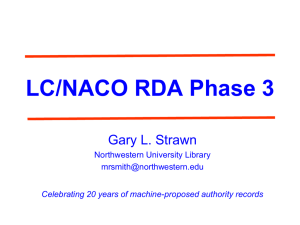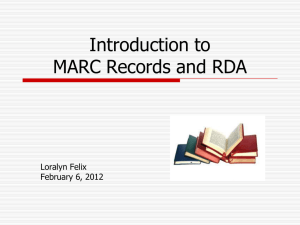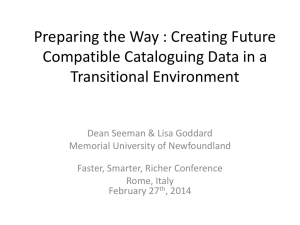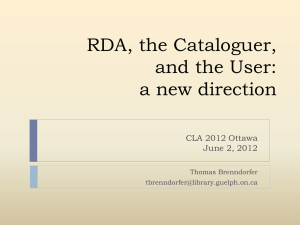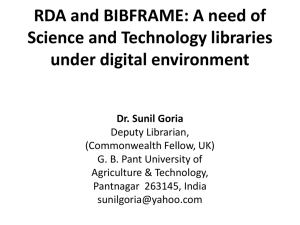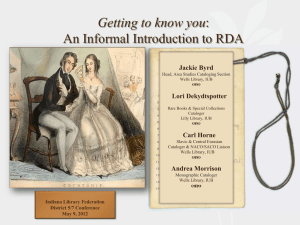Starting RDA Implementation in Arabic Libraries - MENA-IUG
advertisement
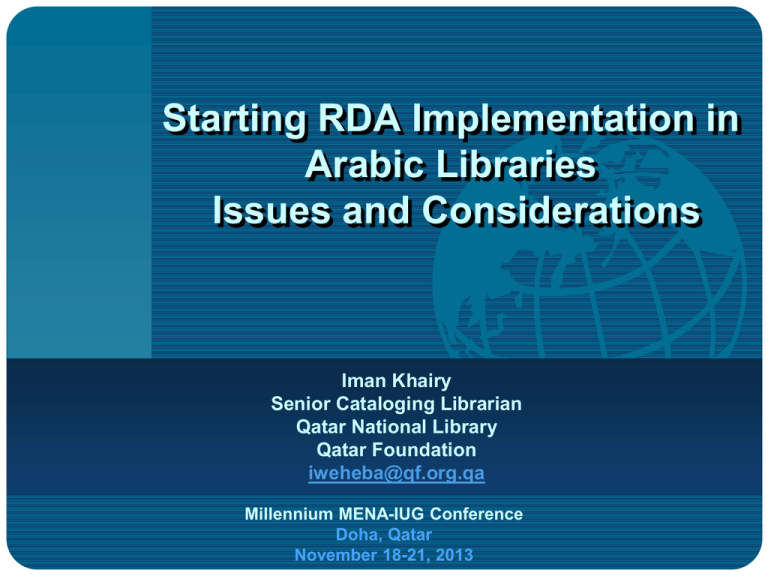
Starting RDA Implementation in Arabic Libraries Issues and Considerations Iman Khairy Senior Cataloging Librarian Qatar National Library Qatar Foundation iweheba@qf.org.qa Millennium MENA-IUG Conference Doha, Qatar November 18-21, 2013 Outline • General Overview of RDA • AACR2-RDA Comparisons • Implementation Plan • Conclusion General Overview of RDA • • • • • • What is RDA? Why RDA? What’s wrong with AACR? Who are the developers of RDA? Historical Background Preparing for RDA AACR2-RDA Comparison • • • • • Things that stay the same Some changes to know about Things that are different Rules affecting Arabic cataloging AACR2 vs. RDA/FRBR and ILS Implementation Plan • • • • • When? Budget? Training? Cataloging data changes? ILS changes? What is RDA? • RDA stands for: Resource Description and Access • New cataloging standard that will replace AACR2 • Data content standard, not a display or encoding standard • Intended to be more international and less Anglo centric What is RDA? • Based on FRBR (Functional Requirements for Bibliographic Records) and FRAD (Functional Requirements for Authority Records) • RDA can be used with MARC, but is structured to work with other data formats such as Dublin Core Why RDA? • • • • New Formats and Types Designed for Online Environment To Be More International Change of Users’ Expectations What’s wrong with AACR? • Lack of logical structure • Mixing content and carrier data • (manuscript on microform, map on DVD, etc.) • • • • • Hierarchical relationships missing Anglo-American centric Written before FRBR Not enough support for collocation Before Internet, metadata and digital environment Based on slide from Barbara B. Tillett, Univ. of Florence Who are the developers of RDA? Joint Steering Committee for Development of RDA (JSC): • • • • • • • Australian Committee on Cataloguing (ACOC) American Library Association (ALA) British Library (BL) Canadian Committee on Cataloguing (CCC) Chartered Institute of Library and Information Professionals (CILIP) Deutsche Nationalbibliothek (DNB) Library of Congress (LC) Historical Background • 1997: International Conference on the Principles & Future Development of AACR, Toronto • 1998: FRBR Published by IFLA • 2002-2004: Work on new standards AACR3 • 2005: AACR3 developed to be RDA Historical Background • 2006-2007: community reviews of draft portions of RDA • More drafts and revisions on RDA • June 22, 2010: Public release of RDA Toolkit • July 1st 2010 – Dec. 2010: Training, Testing; creating records • January 1 – March 31, 2011: analysis and evaluation Historical Background • June 2011: Big RDA announcement • (postpone implementation, no sooner than January 2013) • 2011-2012: LC RDA Training • Conducted by Program for Cooperative Cataloging (PCC) • March 31, 2013: RDA Implementation • LC and LC’s partner national libraries Preparing for RDA Glossary RDA Toolkit Rules & Guidelines Resources Training Frequently Used Terminology RDA Toolkit LC-PCC PS Core Elements Core Core if FRBR/FRAD Entities Attributes Relationships WEMI: Work, Expression, Manifestation, Item RDA Terminology Changes • Access point (not added entry) • Authorized access point (Not main entry or headings) • Variant access points (not see references) • Authorized access point for related entity (not see also references) • Preferred title for a work (not uniform title) • Creator (not author) • Preferred access point (not heading) • Carrier description (not physical description) • Preferred sources (not chief source) RDA Toolkit • Available online for subscription • Available through Cataloger’s Desktop • RDA print During 2013, release of the first RDA Print accumulation that will include the RDA updates and reworded RDA chapters released to date. • Translations: Chinese, French, German, and Spanish • Arabic translation (under negotiations) RDA Toolkit • RDA: Organized according to entities and relationships. No chapters for formats • Overall structure: • Sections 1-4: Recording attributes of elements • Sections 5-10: Recording relationships between elements • Appendices A –M (Capitalization, Abbreviations, etc.) • Glossary RDA Toolkit • Includes: • Workflows and other procedural documentation • Mappings of RDA to different schemas, including MARC 21 • Full text of AACR2 • Library of Congress-Program for Cooperative Cataloging Policy Statements (LC-PCC PSs = the successor of LCRI) • MARC Record Examples of RDA Cataloging RDA Toolkit RDA tab >> browse the RDA text RDA Toolkit Tools tab >> links to MARC 21 & more RDA Toolkit Resources tab >> full text of AACR2, links to RDA and more Resource URL RDA Toolkit LC (RDA) http://www.rdatoolkit.org/ JSC & RDA http://www.rda-jsc.org/rdafaq.html RDA & MARC http://www.loc.gov/marc/RDAinMARC29.ht ml Text of FRBR http://www.ifla.org/publications/functionalrequirements-for-bibliographic-records MARC Changes http://www.loc.gov/marc/formatchangesRDA.html http://www.loc.gov/aba/rda Resource URL RDA and OCLC RDA in NACO Training http://www.oclc.org/rda/about.htm DCMZ1 http://www.loc.gov/catdir/cpso/dcmz1.pdf MARC 21 encoding to accommodate new RDA elements 046 and 3XX http://www.loc.gov/aba/pcc/rda/PCC%20R DA%20guidelines/RDA%20in%20NARsSARs_PCC.pdf http://www.loc.gov/marc/authority/ MARC 21 Format for Authority Data http://www.loc.gov/catworkshop/courses/rd a_naco/course%20table.html LC-PCC PSs http://www.loc.gov/aba/rda/lcps_access.ht ml RDA Training Resources • Comprehensive List of RDA Training Resources, categorized by types of formats and librarian specializations is available at: • "RDA Resources." CARLI - Consortium of Academic and Research Libraries in Illinois. http://www.carli.illinois.edu/memprod/i-share/cat/rda-resources (accessed February 19, 2013) AACR2-RDA Comparison • Things that Stay the Same: – RDA is designed to be backward compatible with AACR2 • RDA will be implemented using the MARC21 format – RDA will work with your Integrated Library System (ILS) AACR2-RDA Comparison • Some Changes to Know About: – RDA uses fewer abbreviations than AACR2 – Changes to Bible headings – Rule of Three – Overview of New MARC Fields AACR2-RDA Comparison New MARC Fields Fixed fields AACR2-RDA Comparison New MARC Fields Variable fields AACR2-RDA Comparison New MARC Fields AACR2-RDA Comparison New MARC Fields AACR2-RDA Comparison New MARC Fields AACR2-RDA Comparison New MARC Fields MARC Fields for Content (336), Media (337), and Carrier (338) Types AACR2-RDA Comparison New MARC Fields AACR2-RDA Comparison • Things that are different: – RDA is based on conceptual models for library data (FRBR and FRAD) – RDA is designed to be used as an online product (RDA Toolkit) – RDA hopes to make it possible to move library data onto the Semantic Web and support the use of LinkedData (Linked-Metadata) RDA (FRBR and FRAD) FRBR Groups FRBR/FRAD Entities RDA Group 1 (Primary) [resources] Products of intellectual or artistic endeavors Work Section 2: Attributes of Work and Expression Expression Manifestation Item Group 2 [Creators+] Those responsible for producing Group 1 entities and more Person Group 3 [Subjects] Subjects of intellectual or artistic endeavors Concept Family Corporate Body Object Event Place (All Group 1 & 2 Entities) Section 1: Attributes of Manifestation and Item Section 3: Attributes of Person, Family, and Corporate Body Section 4: Attributes of Concept, Object, Event, and Place RDA (FRBR and FRAD) FRBR User Tasks (Searching for information resources): • Find—to find resources that correspond to the user’s stated search criteria • Identify—to confirm that the resource described corresponds to the resource sought, or to distinguish between two or more resources with similar characteristics • Select—to select a resource that is appropriate to the user’s needs • Obtain—to acquire or access the resource described. RDA (FRBR and FRAD) FRAD user tasks • • • • Find Identify Contextualize Justify Principles to achieve FRAD user tasks • Differentiate • Represent • Language preference • Common usage RDA 4 principles for persons, families, and corporate bodies are meant to meet the FRAD user tasks, they are: find, identify, understand the relationship, and understand why a name has been recorded. They are covered in RDA 8.2. RDA and the Semantic Web RDA as RDF/XML Vocabulary RDA and the Semantic Web RDA as RDF/RDF Vocabulary MARC 21 Transition (Bib-Frame) The BIBFRAME is an undertaking by the Library of Congress and the community to better accommodate future needs of the library community. A major focus of the initiative will be to determine a transition path for the MARC 21 exchange format to more Web based, Linked Data standards. Zepheira and The Library of Congress are working together to develop a Linked Data model, vocabulary and enabling tools / services for supporting this Initiative. http://bibframe.org • MARC21 as BIBFRAME Resources (RDF/XML) RDA and Linked-Data Linked-Data: Linked Data is a methodology for providing relationships between things (data, concepts and documents) anywhere on the web, using URI’s for identifying, RDF/XML for describing, HTTP for publishing these things and relationships in a way that they can be interpreted and used by humans and software. Linked-Data in Libraries • Linked-Metadata? – The “linked-metadata” can also use a cross-referenced URIs in the metadata records as the linking mechanisms for linking metadata elements (names, subject or bibliographic data) across multiple library systems. Linked-Data in Libraries LC authority record with LCCN Permalink Linked-Data in Libraries • Examples of international linkeddata projects: – OCLC WorldCat.org Bibliographic Linked Data Project www.worldcat.org – Virtual International Authority File (VIAF) www.viaf.org – LCSH Multilingual Linked-Data Project http://id.loc.gov Linked-Data in Libraries Linked Data in WorldCat.org Links to VIAF Links to BIBALEX Linked-Data in Libraries VIAF Linked-Authorities Linked-Data in Libraries Advantages of linked data • Building virtual collections • Standards independent • Richer user experience Challenges of linked data • Provenance, governance and sustainability issues • Quality of interlinked data • Developing a workable framework, systems and standards • Needs robust infrastructure not available to every library Rules affecting Arabic cataloging • New better rules for Arabic cataloging: –Qur’an will be used instead of Koran –Titles such as Imam can be added (9.4.1.8 Other Persons of Religious Vocation) –Adding professions or occupations for names differentiation (9.19.1.6 Profession or Occupation) Rules affecting Arabic cataloging Qur’an will be used instead of Koran Rules affecting Arabic cataloging 9.19.1.6 Profession or Occupation Add a term indicating the class of persons engaged in the profession or occupation of the person (see 9.16), if needed to distinguish one access point from another. Make this addition when the following elements are not available: • date of birth and/or death (see 9.19.1.3) or • fuller form of name (see 9.19.1.4) or • period of activity of the person (see 9.19.1.5). Rules affecting Arabic cataloging • Rules that need to be discussed –Dates in both Gregorian and Hijri calendars –Titles beginning with “Kitab” Rules affecting Arabic cataloging Dates in both Gregorian and Hijri calendars Rules affecting Arabic cataloging Dates in both Gregorian and Hijri calendars 0.11.4 Dates Dates recorded in specified elements are transcribed in the form in which they appear on the source of information from which the data are taken. However, allowance is made for recording the data in the form preferred by the agency creating the data, either as a substitute for or in addition to the data in the original form. Rules affecting Arabic cataloging Recording dates in Arabic script numerals (Indian numerals) 0.11.4 Dates Dates appearing in certain other specified elements are also generally recorded in the form in which they appear on the source of information from which the data are taken. However, allowance is made for substituting equivalent numerals in the script preferred by the agency creating the data. Rules affecting Arabic cataloging • Questions about (0.11.4 Dates) – Does it allow s to record both the Gregorian and Hijri dates if both are available? – Does it also allow us to record dates in Arabic script numerals (Indian numerals) that matches Arabic language right to left directionality? – Do we need to add this as a local practice? Rules affecting Arabic cataloging “The answer is yes, of course, if the cataloging agency prefers Hijri, and the date on the resource is not from that calendar, it can be added; or if the date is on the piece as Hijri, then it is transcribed for date of publication, etc. Local practice would reflect what the cataloging agency prefers for situations in RDA that say to follow what the cataloging agency prefers.” – Email from Dr. Barbara Tillett (Chair, Joint Steering Committee for Development of RDA) Rules affecting Arabic cataloging This allowance was already the practice in AACR2 0.11.4 Dates Allowance is also made for adding dates in the Gregorian or Julian calendar if the data on the source of information are not in that form. Ex. 1429 [2008 or 2009] Rules affecting Arabic cataloging • Titles beginning with “Kitab” 100 Bīrūnī, Muḥammad ibn Aḥmad, 973?-1048. Ṣaydanah fī al-ṭibb 400 Bīrūnī, Muḥammad ibn Aḥmad, 973?-1048. Kitāb al-Saydanah fī al-ṭibb 670 Bīrūnī, Muḥammad ibn Aḥmad. Kitāb alSaydanah fī al-ṭibb, 1991 In the above NAR there is no other work cited in 670 without the word Kitāb Rules affecting Arabic cataloging • Titles beginning with “Kitab” Should we submit a proposal to add Kitab as the instruction below given for Sefer? Hebraica Cataloging, notes on LCRI 21.30J “If all an author's works begin with the word "Sefer", then no name/title authority records are needed. If the word "Sefer" does not appear on all an author's works, then a name authority record is made for each title that does use "Sefer" and the appropriate, specific reference is made.” AACR2 Vs. RDA/FRBR and ILS Better Collocation of Bibliographic Data based on RDA/FRBR AACR2 vs. RDA/FRBR and ILS Better Collocation of Bibliographic Data based on RDA/FRBR AACR2 vs. RDA/FRBR and ILS Bibliotheca Alexandrina Started Using VTLS-FRBR Module Implementation Plan • When? The decision will depend on factors such as: First, When the Library ILS will be upgraded to accommodate RDA and MARC changes? Second, When the suppliers of the MARC records (e.g., book vendors) will provide RDAbased cataloging records? Third, the library may wish to defer decisions on RDA until after the national libraries start the actual RDA implementation. Implementation Plan • Budget? Budgeting and purchase decisions for RDA Toolkit, training and other costs. • Training? Identifying training needs and training levels. Cataloging data changes? Retrospective changes (programmatically or manually) Implementation Plan • ILS changes? • RDA and MARC changes impact on the ILS (the Client and OPAC) • Indexing, searching and displaying of new MARC fields • Display of GMDs and the new MARC fields for Content, Carrier, and Media types • Display of tag 264 with split of publisher, distributor, producer, copyright roles • Are OPAC displays intuitive for the users? If not, can we make changes to improve the situation? Implementation Plan Displaying GMDs in GUI Icons Implementation Plan Displaying GMDs as faceted representation Icons Implementation Plan Displaying MARC fields for Content, Media and Carrier Types as entered in bibliographic records Implementation Plan • ILS changes? • Display of multiple 264 fields Provide different labels based on the second indicator value: • 264 _0 = Production • 264 _1 = Publisher • 264 _2 = Distributor • 264 _3 = Manufacturer • 264 _4 = Copyright Implementation Plan Displaying Multiple 264 Fields Conclusion “Don’t panic.” While much of RDA is brand new and points toward a different future for cataloging, there is also much that is familiar to those used to working with AACR2 and MARC 21. It is important for us to know that RDA will be implemented in stages. The first stage is upon us and has been designed to be less disruptive than we may think. Resources • Bell, Joyce. 2012. “RDA Authorities.” [PowerPoint slides]. https://sites.google.com/site/melacataloging/re sources/rda (accessed February 28, 2013] • Biella, Joan. 2012. “RDA and Bibliographic Description.” [PowerPoint slides]. https://sites.google.com/site/melacataloging/re sources/rda (accessed February 28, 2013] Resources • Dagher, Iman. 2012. Getting Ready for RDA. [PowerPoint slides]. https://sites.google.com/site/melacataloging/re sources/rda (accessed February 28, 2013] • Hart, Amy. 2010. "Getting Ready for RDA: What You Need to Know". Library Media Connection. 29 (2): 30-32. Questions? 79 Thank you 80

